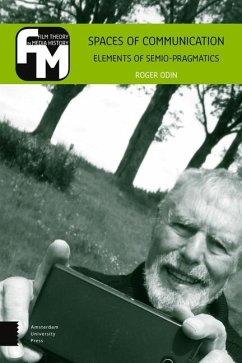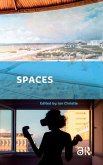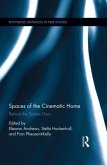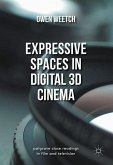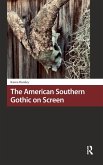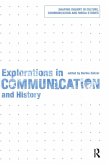- Gebundenes Buch
- Merkliste
- Auf die Merkliste
- Bewerten Bewerten
- Teilen
- Produkt teilen
- Produkterinnerung
- Produkterinnerung
Spaces of Communication offers a concise introduction to semiopragmatics and condenses the intellectual trajectory of one of the foundational figures of film studies into a relatively short and accessible volume.
Andere Kunden interessierten sich auch für
![Spaces Spaces]() Ian ChristieSpaces132,99 €
Ian ChristieSpaces132,99 €![Spaces of the Cinematic Home Spaces of the Cinematic Home]() Spaces of the Cinematic Home186,99 €
Spaces of the Cinematic Home186,99 €![Expressive Spaces in Digital 3D Cinema Expressive Spaces in Digital 3D Cinema]() Owen WeetchExpressive Spaces in Digital 3D Cinema18,99 €
Owen WeetchExpressive Spaces in Digital 3D Cinema18,99 €![The American Southern Gothic on Screen The American Southern Gothic on Screen]() Karen HorsleyThe American Southern Gothic on Screen132,99 €
Karen HorsleyThe American Southern Gothic on Screen132,99 €![Agatha Christie and Gothic Horror Agatha Christie and Gothic Horror]() Stuart RichardsAgatha Christie and Gothic Horror132,99 €
Stuart RichardsAgatha Christie and Gothic Horror132,99 €![Albanian Cinema through the Fall of Communism Albanian Cinema through the Fall of Communism]() Bruce WilliamsAlbanian Cinema through the Fall of Communism132,99 €
Bruce WilliamsAlbanian Cinema through the Fall of Communism132,99 €![Explorations in Communication and History Explorations in Communication and History]() Barbie Zelizer (ed.)Explorations in Communication and History50,99 €
Barbie Zelizer (ed.)Explorations in Communication and History50,99 €-
-
-
Spaces of Communication offers a concise introduction to semiopragmatics and condenses the intellectual trajectory of one of the foundational figures of film studies into a relatively short and accessible volume.
Produktdetails
- Produktdetails
- Verlag: Routledge
- Seitenzahl: 176
- Erscheinungstermin: 22. Dezember 2021
- Englisch
- Abmessung: 240mm x 161mm x 14mm
- Gewicht: 435g
- ISBN-13: 9789462987142
- ISBN-10: 9462987149
- Artikelnr.: 62847560
- Herstellerkennzeichnung
- Libri GmbH
- Europaallee 1
- 36244 Bad Hersfeld
- gpsr@libri.de
- Verlag: Routledge
- Seitenzahl: 176
- Erscheinungstermin: 22. Dezember 2021
- Englisch
- Abmessung: 240mm x 161mm x 14mm
- Gewicht: 435g
- ISBN-13: 9789462987142
- ISBN-10: 9462987149
- Artikelnr.: 62847560
- Herstellerkennzeichnung
- Libri GmbH
- Europaallee 1
- 36244 Bad Hersfeld
- gpsr@libri.de
Roger Odin is emeritus professor of Communication at Paris 3 University; Head of the Film and Audiovisual Institute (1983-2003); Theorist of the semio-pragmatic approach (De la fiction, 2000; Les Espaces de Communication , 2011).
A Democracy of Readings and Objects: Roger Odin's Contribution to the Theory of Film (Vinzenz Hediger)
What We Make of Images and Sounds: Semio-Pragmatics as Approach and Method
Establishing a Discipline
Cultivating a Field: Roger Odin and Film Studies in France
Moving Semiotics Forward: Semio-Pragmatics and Film Theory since the 1960s
Beware of the Crypt: Semio-Pragmatics and the Question of Communication
After the Elegy of Cinema: Semio-Pragmatics and the State of Film Studies
Spaces of Communication: Elements of Semio-Pragmatics (Roger Odin)
Foreword and Acknowledgements
Introduction: The Semio-Pragmatic Model
On the Difficulty of Getting Away from Immanence
On the Difficulty of Staying Within Immanence
Vacillation
For an Articulation between the Two Paradigms: Semio-Pragmatics
The Semio-Pragmatic Model
1. Context
Constraints and the Space of Communication
Universally Shared Constraints
Natural Constraints
The Narrative Constraint
The Case of Languages
Language and Perception
The Influence of a Language on How We Read Images
Non-Natural Constraints and the Notion of the Space of Communication
2. The Discursive Space : Communicative Competence and Modes of Production of Meaning
Fictionalizing Mode (First Approach)
Spectacularizing and Energetic Modes
Documentarizing Mode
Moralizing Mode
Fictionalizing Mode (Second Approach); Fabulating Mode
3. Aesthetic Mode
Artistic Mode: Relationship between Modes and Spaces
From the Aesthetic Mode to Aesthetic Spaces
From the Artistic Mode (in Reduced Form) to Inscription in the Space of Art
From the Artistic Mode (Full-Fledged Form) to the Spaces of Art
Relationship among Modes and among Spaces
4. Contextual Analysis and the Space of Communication: The Space of Communication of Family Memory
The Space of Communication for Memory in the Traditional Family
The Constraints and the Construction of the Actants
Which Mode(s) to Construct? Private Mode
Intimate Mode
Communication Operators
The Space of Communication for Memory in the New Family Structure
Freed-Up Communication
Testimony Mode: Another Mode of Production of Meaning
Other Memory Operators
5. The Space of Communication and Migration: The Example of the Home Movie
The Home Movie: From Archives to Loci of Memory
The Home Movie on Television
From Home Movie to Micro-Histories
The Home Movie in the Space of Art
The Home Movie in the Medical Context
6. Textual Analysis and Semio-Pragmatics
A Stage of the Tour de France on Television
Interpreting the Reproduction of a Painting
Collective Academic Research
The Space of Description and the Construction of the Object of Analysis
From the Space of Textual Analysis to the Space of Interpretation
The Space of Ideological Analysis
The Space of Epistemological Reflection
The Place of Cinema in the Academic Institutional Space
Conclusion
List of Tools
The Different Stages of Construction of the Semio-Pragmatic Model
Bibliography
Index
What We Make of Images and Sounds: Semio-Pragmatics as Approach and Method
Establishing a Discipline
Cultivating a Field: Roger Odin and Film Studies in France
Moving Semiotics Forward: Semio-Pragmatics and Film Theory since the 1960s
Beware of the Crypt: Semio-Pragmatics and the Question of Communication
After the Elegy of Cinema: Semio-Pragmatics and the State of Film Studies
Spaces of Communication: Elements of Semio-Pragmatics (Roger Odin)
Foreword and Acknowledgements
Introduction: The Semio-Pragmatic Model
On the Difficulty of Getting Away from Immanence
On the Difficulty of Staying Within Immanence
Vacillation
For an Articulation between the Two Paradigms: Semio-Pragmatics
The Semio-Pragmatic Model
1. Context
Constraints and the Space of Communication
Universally Shared Constraints
Natural Constraints
The Narrative Constraint
The Case of Languages
Language and Perception
The Influence of a Language on How We Read Images
Non-Natural Constraints and the Notion of the Space of Communication
2. The Discursive Space : Communicative Competence and Modes of Production of Meaning
Fictionalizing Mode (First Approach)
Spectacularizing and Energetic Modes
Documentarizing Mode
Moralizing Mode
Fictionalizing Mode (Second Approach); Fabulating Mode
3. Aesthetic Mode
Artistic Mode: Relationship between Modes and Spaces
From the Aesthetic Mode to Aesthetic Spaces
From the Artistic Mode (in Reduced Form) to Inscription in the Space of Art
From the Artistic Mode (Full-Fledged Form) to the Spaces of Art
Relationship among Modes and among Spaces
4. Contextual Analysis and the Space of Communication: The Space of Communication of Family Memory
The Space of Communication for Memory in the Traditional Family
The Constraints and the Construction of the Actants
Which Mode(s) to Construct? Private Mode
Intimate Mode
Communication Operators
The Space of Communication for Memory in the New Family Structure
Freed-Up Communication
Testimony Mode: Another Mode of Production of Meaning
Other Memory Operators
5. The Space of Communication and Migration: The Example of the Home Movie
The Home Movie: From Archives to Loci of Memory
The Home Movie on Television
From Home Movie to Micro-Histories
The Home Movie in the Space of Art
The Home Movie in the Medical Context
6. Textual Analysis and Semio-Pragmatics
A Stage of the Tour de France on Television
Interpreting the Reproduction of a Painting
Collective Academic Research
The Space of Description and the Construction of the Object of Analysis
From the Space of Textual Analysis to the Space of Interpretation
The Space of Ideological Analysis
The Space of Epistemological Reflection
The Place of Cinema in the Academic Institutional Space
Conclusion
List of Tools
The Different Stages of Construction of the Semio-Pragmatic Model
Bibliography
Index
A Democracy of Readings and Objects: Roger Odin's Contribution to the Theory of Film (Vinzenz Hediger)
What We Make of Images and Sounds: Semio-Pragmatics as Approach and Method
Establishing a Discipline
Cultivating a Field: Roger Odin and Film Studies in France
Moving Semiotics Forward: Semio-Pragmatics and Film Theory since the 1960s
Beware of the Crypt: Semio-Pragmatics and the Question of Communication
After the Elegy of Cinema: Semio-Pragmatics and the State of Film Studies
Spaces of Communication: Elements of Semio-Pragmatics (Roger Odin)
Foreword and Acknowledgements
Introduction: The Semio-Pragmatic Model
On the Difficulty of Getting Away from Immanence
On the Difficulty of Staying Within Immanence
Vacillation
For an Articulation between the Two Paradigms: Semio-Pragmatics
The Semio-Pragmatic Model
1. Context
Constraints and the Space of Communication
Universally Shared Constraints
Natural Constraints
The Narrative Constraint
The Case of Languages
Language and Perception
The Influence of a Language on How We Read Images
Non-Natural Constraints and the Notion of the Space of Communication
2. The Discursive Space : Communicative Competence and Modes of Production of Meaning
Fictionalizing Mode (First Approach)
Spectacularizing and Energetic Modes
Documentarizing Mode
Moralizing Mode
Fictionalizing Mode (Second Approach); Fabulating Mode
3. Aesthetic Mode
Artistic Mode: Relationship between Modes and Spaces
From the Aesthetic Mode to Aesthetic Spaces
From the Artistic Mode (in Reduced Form) to Inscription in the Space of Art
From the Artistic Mode (Full-Fledged Form) to the Spaces of Art
Relationship among Modes and among Spaces
4. Contextual Analysis and the Space of Communication: The Space of Communication of Family Memory
The Space of Communication for Memory in the Traditional Family
The Constraints and the Construction of the Actants
Which Mode(s) to Construct? Private Mode
Intimate Mode
Communication Operators
The Space of Communication for Memory in the New Family Structure
Freed-Up Communication
Testimony Mode: Another Mode of Production of Meaning
Other Memory Operators
5. The Space of Communication and Migration: The Example of the Home Movie
The Home Movie: From Archives to Loci of Memory
The Home Movie on Television
From Home Movie to Micro-Histories
The Home Movie in the Space of Art
The Home Movie in the Medical Context
6. Textual Analysis and Semio-Pragmatics
A Stage of the Tour de France on Television
Interpreting the Reproduction of a Painting
Collective Academic Research
The Space of Description and the Construction of the Object of Analysis
From the Space of Textual Analysis to the Space of Interpretation
The Space of Ideological Analysis
The Space of Epistemological Reflection
The Place of Cinema in the Academic Institutional Space
Conclusion
List of Tools
The Different Stages of Construction of the Semio-Pragmatic Model
Bibliography
Index
What We Make of Images and Sounds: Semio-Pragmatics as Approach and Method
Establishing a Discipline
Cultivating a Field: Roger Odin and Film Studies in France
Moving Semiotics Forward: Semio-Pragmatics and Film Theory since the 1960s
Beware of the Crypt: Semio-Pragmatics and the Question of Communication
After the Elegy of Cinema: Semio-Pragmatics and the State of Film Studies
Spaces of Communication: Elements of Semio-Pragmatics (Roger Odin)
Foreword and Acknowledgements
Introduction: The Semio-Pragmatic Model
On the Difficulty of Getting Away from Immanence
On the Difficulty of Staying Within Immanence
Vacillation
For an Articulation between the Two Paradigms: Semio-Pragmatics
The Semio-Pragmatic Model
1. Context
Constraints and the Space of Communication
Universally Shared Constraints
Natural Constraints
The Narrative Constraint
The Case of Languages
Language and Perception
The Influence of a Language on How We Read Images
Non-Natural Constraints and the Notion of the Space of Communication
2. The Discursive Space : Communicative Competence and Modes of Production of Meaning
Fictionalizing Mode (First Approach)
Spectacularizing and Energetic Modes
Documentarizing Mode
Moralizing Mode
Fictionalizing Mode (Second Approach); Fabulating Mode
3. Aesthetic Mode
Artistic Mode: Relationship between Modes and Spaces
From the Aesthetic Mode to Aesthetic Spaces
From the Artistic Mode (in Reduced Form) to Inscription in the Space of Art
From the Artistic Mode (Full-Fledged Form) to the Spaces of Art
Relationship among Modes and among Spaces
4. Contextual Analysis and the Space of Communication: The Space of Communication of Family Memory
The Space of Communication for Memory in the Traditional Family
The Constraints and the Construction of the Actants
Which Mode(s) to Construct? Private Mode
Intimate Mode
Communication Operators
The Space of Communication for Memory in the New Family Structure
Freed-Up Communication
Testimony Mode: Another Mode of Production of Meaning
Other Memory Operators
5. The Space of Communication and Migration: The Example of the Home Movie
The Home Movie: From Archives to Loci of Memory
The Home Movie on Television
From Home Movie to Micro-Histories
The Home Movie in the Space of Art
The Home Movie in the Medical Context
6. Textual Analysis and Semio-Pragmatics
A Stage of the Tour de France on Television
Interpreting the Reproduction of a Painting
Collective Academic Research
The Space of Description and the Construction of the Object of Analysis
From the Space of Textual Analysis to the Space of Interpretation
The Space of Ideological Analysis
The Space of Epistemological Reflection
The Place of Cinema in the Academic Institutional Space
Conclusion
List of Tools
The Different Stages of Construction of the Semio-Pragmatic Model
Bibliography
Index

